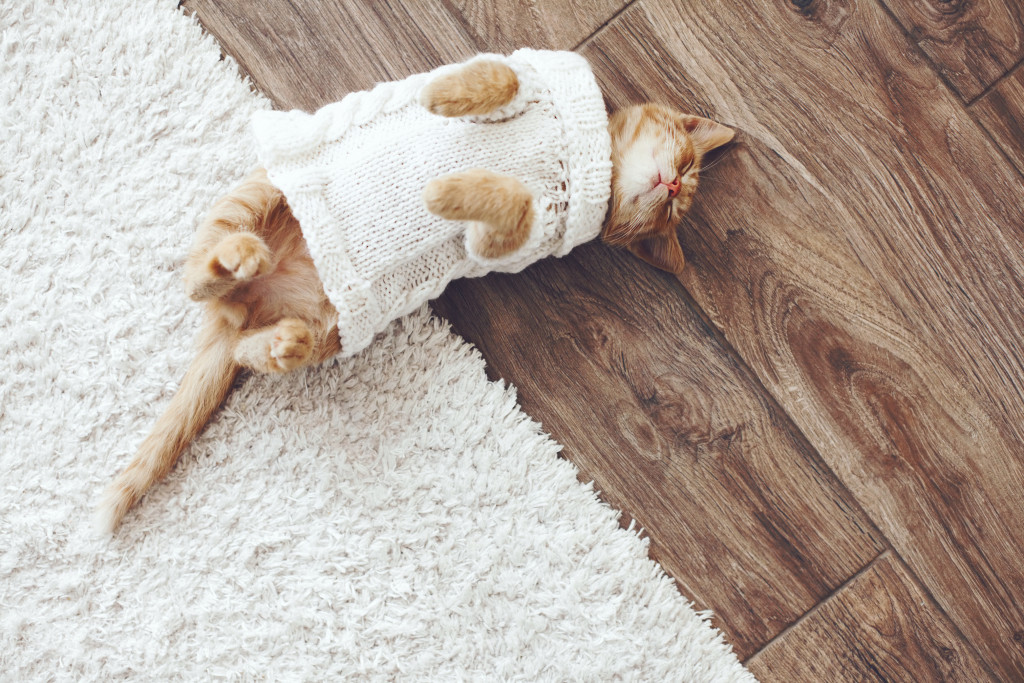- Use furniture touch-up pens, wood fillers, and leather repair kits for minor repairs.
- Hire an experienced home siding contractor if there is siding damage from chewing.
- Blot carpet stains with a paper towel or cloth and use a pet-specific enzymatic cleaner to remove odors.
- Trim your pet’s claws to prevent further damage to furniture and curtains.
- Sandpaper, primer, and paint can be used to repair paint scratches.
If you’re a pet parent, you know the joy and love of having your furry companion around. However, as much as you love your pets, they can sometimes cause damage to your home.
Pet damage can be frustrating and costly, from scratches on furniture to chewed-up shoes. But don’t worry – repairing pet damage is possible with some patience and effort. This post will provide you with a guide on how to repair joint pet damage at home.
Scratches on furniture
Many pet parents have experienced their furry friends scratching furniture, whether it’s the couch, the bed frame, or any wooden surface. To repair scratches, start by evaluating the damage. If it’s a minor scratch, you can use a furniture touch-up pen that matches the wood color to hide it.
For deeper scratches, use a wood filler and sandpaper to fill and smooth the scratch, then apply matching color stain and sealant. For leather furniture, you can use a leather repair kit that matches the color of the leather.
Chewing the siding

Pets like dogs are known for chewing on wooden siding and creating unsightly holes. To repair this, you’ll need to hire an experienced home siding contractor to replace the damaged boards and replace them with new ones.
These experts will be able to match the color and texture of your siding so it looks as good as new. With the right team on your side, you can watch those chew marks become a thing of the past and focus on enjoying all the other joys of being a pet owner.
Carpet stains
Pet accidents can be challenging to clean, especially if they’ve soaked into the carpet fibers. To remove stains and odors, start by blotting the area with a paper towel or cloth to absorb as much liquid as possible.
Mix equal vinegar and water, and apply the solution to the stain. Let it sit for a few minutes, then blot the area again. You can also use a pet-specific enzymatic cleaner that contains bacteria and enzymes that break down stains and odors.
Claw marks
If you have a cat, you’re probably familiar with the claw marks they leave on furniture and curtains. To repair furniture claw marks, start trimming your cat’s claws regularly to prevent further damage. Use a furniture touch-up pen or wood scratch repair kit to fill in the effects. Try sewing a patch of matching fabric over the area with claw marks for curtains.
Paint scratches
If your pet has scratched the paint on walls or baseboards, repairing it is easier than you think. First, clean the area with a damp cloth to remove dirt or debris. Use sandpaper to smooth out the scratch, and then apply primer and paint that matches the existing color. You may want to call a professional painter for a flawless finish for large areas.
Prevention tips
The best way to repair pet damage is to prevent it from happening in the first place. Here are some tips to help you get started.
Keep your pet entertained

A bored pet is a destructive pet. When pets don’t get enough attention and exercise, they find their own entertainment, often damaging your home. Keeping your pet entertained by providing toys and playtime is essential to prevent them from becoming destructive.
Provide a designated space for your pet
Providing your pet with a designated space of their own is a great way to prevent them from causing damage to your home. This could be a crate or a designated room with their favorite toys and bedding.
Train your pet
Training your pet is crucial to prevent them from damaging your home. If your pet is not prepared correctly, they may not understand what is and isn’t permissible behavior, and they may choose to scratch or chew on furniture or other household items.
Keep claws trimmed
Pets naturally scratch and claw at things, but keeping their claws trimmed is essential to prevent damage to your furniture, carpets, and other household items. If you’re unsure how to decorate your pet’s nails, take them to a professional groomer.
Wrapping up
As a fur parent, accepting that pet damage may happen is essential. However, with patience and effort, repairing pet damage can be a relatively simple and cost-effective process. Remember, the key is to address the behavior that caused the damage and provide your pets with appropriate toys and training. With these tips and a little love, you can keep your furry friends and home in excellent condition.




